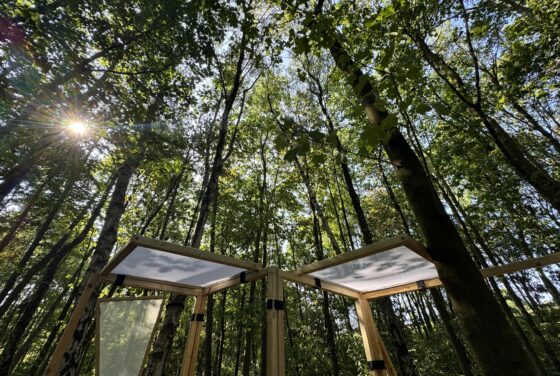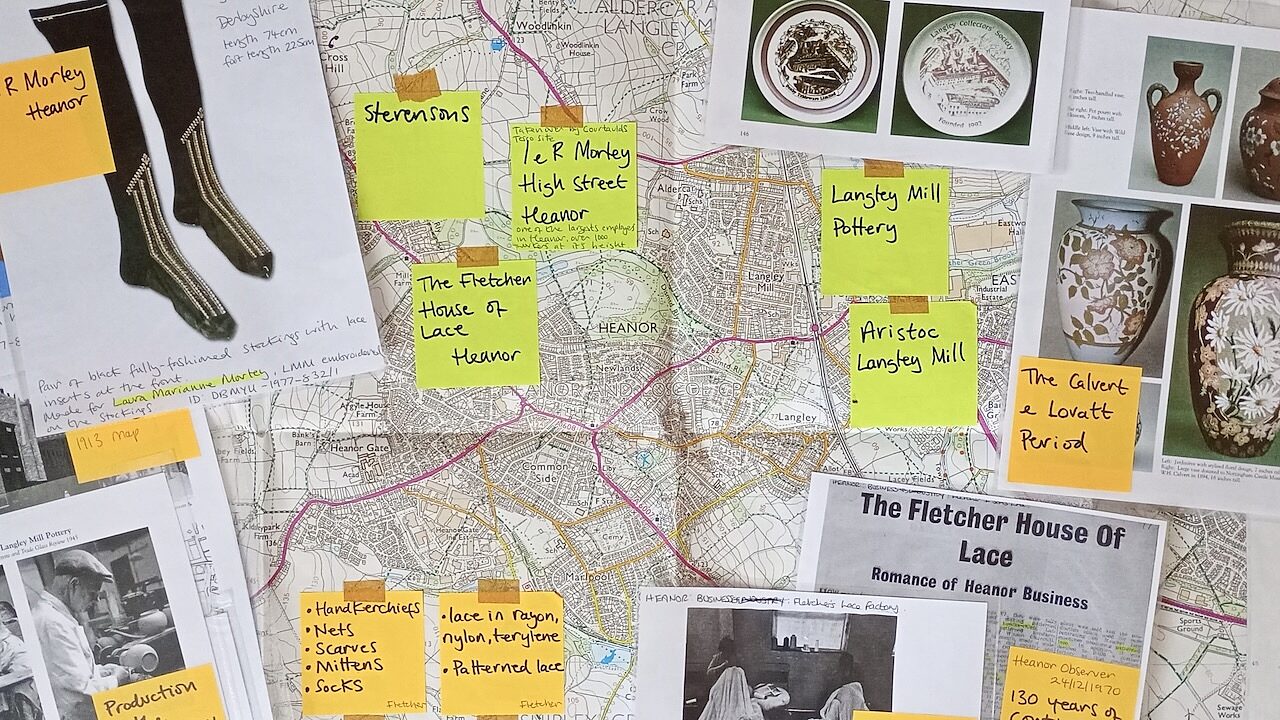
Artist Karen Logan shares her research findings
DATE
Researching textiles heritage in Heanor
During the two years I lived in Langley Mill, I heard whispers of past industry and factories but it wasn’t until the Derbyshire Makes Dare to Dream project that I walked up the hill to Heanor library, and with the guidance of the wonderful staff there, began to understand how diverse and skilled the labour force of the area had been.
My research focus was textiles, but I couldn’t exclude Langley Mill Pottery. Reading articles about I & R Morley and Fletcher House of Lace in Heanor, Langley Mill Pottery and Aristoc in Langley Mill, I was fascinated to discover the range of products made locally. Fletcher made handkerchiefs, hats, scarves, mittens, socks, fully fashioned hosiery, silk stockings, patterned lace and lace in rayon, nylon and terylene. During WW2 Aristoc made barrage balloons, rubber dinghies, life jackets and rain coats.
Searching online I found memories shared by Vera Huntchinson who moved to Langley Mill in 1938 as her husband Wilf worked at Aristoc. In 2004 Vera contributed to the WW2 People’s War archive of World War Two memories - written by the public, gathered by the BBC. Vera paints an evocative picture, sharing how working at Aristoc, ‘Whatever job you did, there was always a strong smell of rubber which seemed to impregnate your clothes and you took the smell home with you. When the workers left for home, either by bus or train, you knew instantly where they worked. If they smelled of rubber they were from Aristoc, Collaros' workforce smelled of oil!’ Collaro Ltd engaged in munitions work.
Heanor Library has copies of the book Langley Mill Pottery Its History and Its Wares by John and Jenifer Giblin. I poured over pictures, amazed to discover the small shopping parade I visited for cat treats and charity shop rummages was once a centre of industry - Langley Mill Pottery in production from 1865 - 1982, 117 years of stoneware production! It’s easy to imagine a highly skilled workforce streaming from Langley Mill Station next to the site. There is a blue plaque outside B&M Bargains commemorating the pottery.
Leading the fashions of the day, the pottery went through five distinct periods of ownership, producing a wide range of stoneware, including salt glazed ink bottles, utilitarian items and tableware to high quality original art pottery. Personally, I’m particularly drawn to Langley Wear by Mary Helen Goodyear and The Calvary & Lovatt Period featuring realistic plant, insect and bird forms (1880’s-1890’s). Observing the decorated pottery I can’t help but think about how the people designing them would have experienced agricultural land and hedgerows as flourishing and noisy with wildlife, how as the pottery has been erased so has nature - the UK being one of the most nature-depleted countries in the world. Absence upon absence.
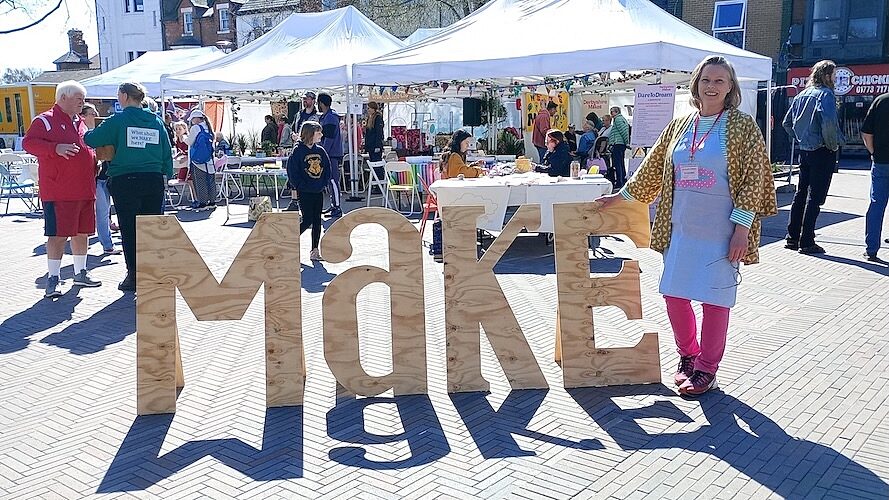
Wondering upon how to share my research with visitors to the Derbyshire Makes Festival in Heanor over the first weekend of April 2025, I ordered a map online with Heanor at its centre, adding post-it notes naming factories and listing what was manufactured locally. I also included colour photocopies from the Langley Mill Pottery book, showcasing designs from its different eras, and images of people working in the factory during the 1940’s, 50’s & 80’s, highlighting their names in fluorescent pen. Would anyone know them, remember them? Were the names local? One was - Langley! How about Whysall, Turton, Haggerty, Issard, Hart, Brindley, Lees, Harbon, Holland, Winters and Martin? Would their families know them? Would they be claimed?
I hung the map and research up at the Festival, hoping to inspire visitors to stitch a textile patch for the Dare to Dream mass participation project. The map and images were a real talking point, locals sharing memories of these factories, how family members worked there, how their first job after school was at the factory. Some visitors were amazed to learn about these thriving industries, calling friends over with surprise and excitement.
As someone who is interested in the hidden stories of everyday people, with a desire to look at, question, imagine, consider what is lost, how loss is overlaid… A walk to a shopping centre becomes alive with wonder, fizzing with imagination, following the footsteps of a multitude of unknown people. My present, their present, now past - shall we meet outside the factory?
I wonder at their journeys to work, the friendships and relationships made, what songs filled their heads? Were they proud of their skills? How did labour shape their bodies, their thinking? Vera shares, ‘For such a small village, thousands were employed in Langley Mill. Not just the surrounding towns of Heanor, Eastwood, Kimberley, Ripley, Ilkeston etc, but as far as Chesterfield, Alfreton and other stations on route to Langley Mill by rail.’ How devastating the loss of these industries to local people, the impact of decline must have been immense. How did the workforce navigate this?
I wonder what Vera Huntchinson would make of Dare to Dream? She speaks of ‘make do and mend’, mentioning her hand operated sewing machine and training as a cutter and tailor, able to eke out the family's clothes rationing coupons artfully. Vera used parachute panels from the Army and Navy stores to make luxury undies and nighties with hand embroidery for a touch of class. Go Vera! Repurposing and upcycling before our current focus on repurposing and upcycling.
Taking a breath, breathing life into memories, breathing life into hopes and dreams for the future I’ve been working with the Heanor Library Craft Group at the library and Sewing Group that meets at Infinite Wellbeing. At our last meet ups I was bowled over by the generosity and care in the creation of their textile patches for the Dare to Dream banner - I saw their stitched work as a love letter to Derbyshire, a love letter to Langley Mill and Heanor.
Written by Karen Logan, Dare to Dream artist.
MORE NEWS
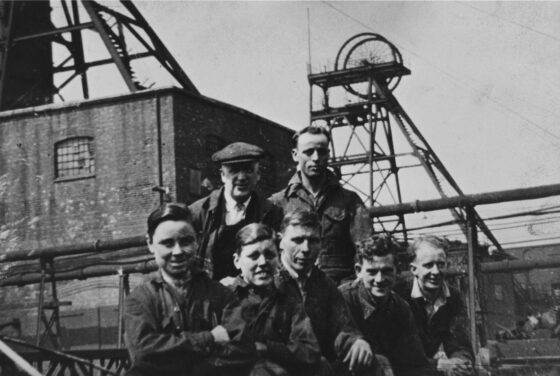
Derbyshire Makes History Film Commission
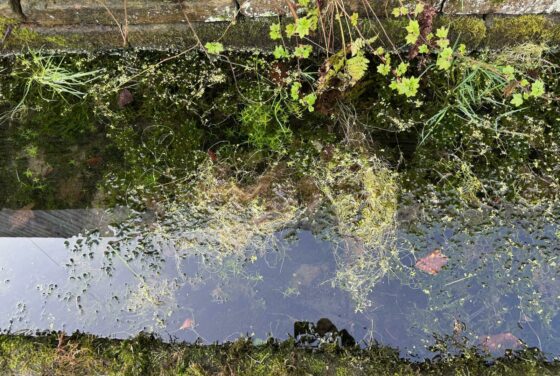
Wisdom of Water: Making Space at Whitfield Well
